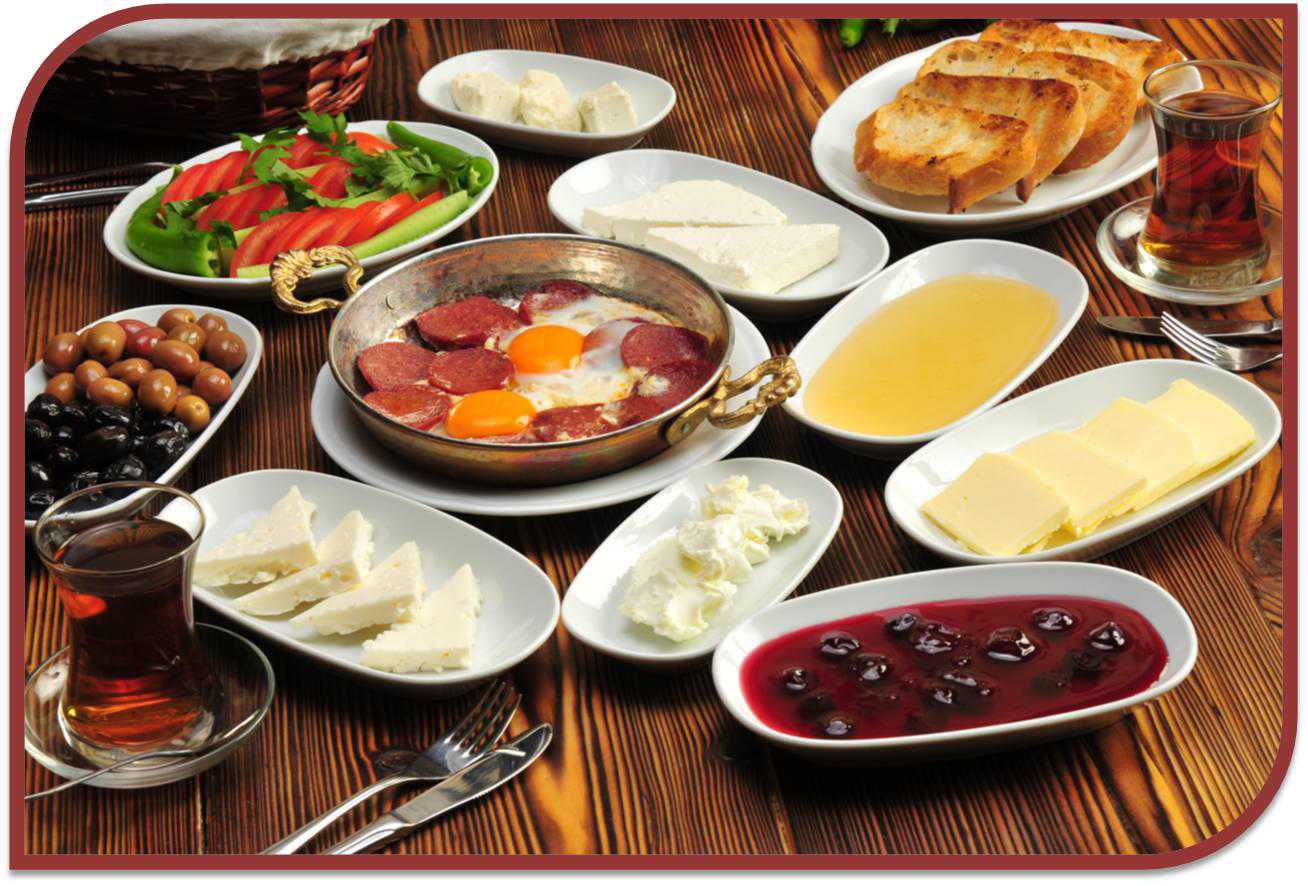
Tag: Turkish Traditions
-

Turkish Breakfast
A typical Turkish breakfast consists of cheese (beyaz peynir, kaşar etc.), butter, olives, eggs, tomatoes, cucumbers, green peppers, reçel (jam/marmalade; a preserve of whole fruits) and honey usually consumed on top of kaymak. Sucuk (spicy Turkish sausage), pastırma, börek, simit, poğaça and even soups can be taken as a morning meal in Turkiye. Perhaps more so than traditional breads such as pide, a crusty white loaf is widely consumed. A common Turkish speciality for breakfast is called menemen, which is prepared with roasted tomatoes, peppers, olive oil and eggs. Invariably, Turkish Tea is served at breakfast. The Turkish word for breakfast, kahvaltı, means “before coffee” (kahve, ‘coffee’; altı, ‘under’).
-
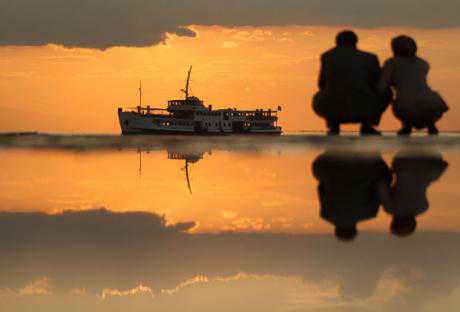
Wake up and smell the coffee in Turkey’s beautiful Izmir
Travellers need only take a stroll down Izmir’s Kordon promenade to be transported back into a forgotten world of Turkish coffee culture as Sarah Knapton found out.
By Sarah Knapton
It’s unlikely that you will have heard of Pasqua Rosee. And yet, on your average walk to work, you probably pass more reminders of his legacy than anyone else’s.
Turkish coffee has changed little in 500 yearsRosee brought coffee to London. He opened his first coffee house in a shed in the churchyard of St Michael’s Alley, Cornhill in 1652. Rosee was the servant of a British goods trader named Daniel Edwards. Edwards had met Rosee in Izmir, Turkey, and brought him back to England, along with his recipe for a rich, thick mud-like drink known as “coffee.”
So popular was this new drink with Edwards’ London friends that he arranged for the beans to be imported and helped Rosee set up his first business.
It was the start of a gastro-financial revolution. By 1675 there were more than 3,000 coffeehouses in England and Rosee had branched out in Europe, establishing Paris’ first coffee shop in 1672.
His coffee house eventually inspired Procpopio Cuto to open the Café Procope which brought together the likes of Votaire, Rousseau and Thomas Jefferson and sparked the French enlightenment.
And by 1688 Edward Lloyd, encouraged by the success of Rosee, had opened his own coffeehouse – Lloyds of London. It became an important meeting place for sailors, merchants, and ship owners and Lloyd kept them up to date with reliable shipping news. It was here that the modern insurance industry and stock market was born.
And Turkish coffee, or kahve, had been responsible.
The endlessly inventive milky, frothy, frappa-latte-chinos churned out by Starbucks today bear little resemblance to the thimbles of muddy exotica enjoyed by the 17th century renaissance gentleman. But if you visit Izmir today you can still taste a drink which has changed little in half a millennium.
And all in a setting that inspired Homer to pen The Iliad and encouraged Alexander the Great to stop conquering for a while and take in the view.

Prepared by boiling finely powdered roasted beans in a pot – or cezve – the coffee is left to settle into a thick, strong, sludge. The drinker can usually manage around four or five sips before the dregs at the bottom become too viscous to finish.
So ingrained is coffee in Turkish culture that the Turkish word for breakfast, kahvaltı, means “before coffee” while the word for brown is kahverengi, literally “the colour of coffee”.
The Turks believed coffee to be a strong aphrodisiac and a spouse refusing to drink it was a legitimate cause for divorce.
In Izmir you would be pushed to find a more tranquil or historically important spot to enjoy a cup than by the harbour. Dubbed “beautiful Izmir’ by the Turks, the city sits barely more than a few feet above the tideless Aegean, surrounded by mountains.
The climate is balmy and Mediterranean but the scorching summers are cooled by the refreshing sea breezes.
The palm lined promenade of Kordon is bustling with bars, restaurants and coffee houses and gives off an exotically evocative aroma of Shisha pipes, spices and, of course, coffee.
It faces west making it an ideal spot to catch the setting sun as it sinks into the harbour. The impressive Konak pier was designed by Gustave Eiffel. Its lattice work is based on the same engineering which holds up the Eiffel tower and the Statue of Liberty.
Almost all of the great ancient empires, the Lydians, Persians, Romans and Ottomans, to name but a few, have seen their empires rise and fall between the walls of Izmir.
And looking out across the water over to the mountains it is easy to see why settlers chose the port more than 8,500 years ago.
Legend has it that the city was founded by the Amazons and was originally named Smyrna after the warrior-queen of Hellenistic mythology. The city was the birthplace of Homer and The Iliad was first recounted on the banks of the Meles stream, between 750-700 BC.
Modern day Izmir, however stands on a slightly different spot to the original footprint of Smyrna, a curiosity brought about by Alexander the Great who according to legend was visited by the goddess Nemesis in a dream having stopped to rest on Mt Pagus, a hill outside the walls of the original city. Nemesis ordered the city be moved to the hillside.
Whether anyone seemed to object to such a whimsical uprooting of an entire city is not recorded. The oracle of Claros predicted the citizens would be four times happier than before.
Undoubtedly the city continued to prosper, largely driven by its location on important trade routes. Aristotle even travelled to give lectures nearby for three years.
Strabo, the ancient geographer wrote that Izmir was the most beautiful Ionian city of the time, even rivaling nearby Ephesus.
And a visit to Ephesus gives some hint as to how astonishing Izmir must have been in ancient times.
At its height, Ephesus was the capital of the Asian part of the Roman Empire and housed a population of 200,000. Although only partly excavated Ephesus is a vast sprawling reminder of how advanced ancient cultures were. It is still possible to walk down one of the multitude of ruined streets on a busy day in the tourist season and not encounter another soul.
Cleopatra, Marc Anthony and St Paul all visited the city and it held the magnificent Temple of Artemis, one of the seven wonders of the ancient world. Although the temple has now gone, the façade of the Celsus Library is arguably one of the most beautiful and impressive examples of Roman architecture left standing. It was the third largest library in the classical world. Visitors entering the library can still pass the same four female statues representing wisdom, character, judgement and experience.
Legend has it that Mary, the mother of Jesus, came to live near Ephesus with St John shortly before her death. Both Christian and Muslim pilgrims still travel to the small house on Mount Bulbul in which locals believed she died on August 15th every year. The grave of St John is also to be found nearby, under a later basilica.
Izmir finds itself at the crossroads of civilisations. It was the east of the west and the west of the east where culture, religion and mystics gathered and fused into elaborate tapestry. Mosques, synagogues and churches still sit happily side-by-side in testament to its embracing and liberal attitude.
It is no wonder that amid such a convivial atmosphere of acceptance that the coffee houses flourished when they were first introduced in the middle of the 15th century. And with them came a whole mysticism of their own.
While the Chinese were staring into tea leaves, a similar way of telling the future was being decoded from the coffee grounds in Turkey.
Even today the locals are quick to swipe your cup away and peer into the dregs to pick out the shape of a butterfly or a ring or a mounted rider.
And the mysterious potency of coffee travelled with the beans to London. It was said the new drink could stop headaches, cure wind, gout, scurvy, prevent miscarriages and sore eyes.
It is unsurprising that coffee took on such allure given the area from which it originated. Izmir has been famed as a spot for healing since ancient times.
The Agamemnon Spas which were cited by Homer are now known as the Balcova Spas and it is said their thermal waters can cure upper respiratory conditions, chronic infections, rheumatism, metabolism and skin problems. The spas at Cesme are also said to cure genealogical, urinary and liver problems. In the volcanic landscape of Alacati herbal baths are prepared using the waters which are renowned for treating bone and joint disorders.
The region is also peppered with Turkish bath houses. So if you don’t wish to drink the mud there will always be someone nearby to coat you in it.
Yet it is likely the famed good health of Izmir’s inhabitants was largely to do with the diet of its people.
Despite straddling two continents the cuisine of Izmir is far more European than Asian.
The oldest olive oil workshop in the world is found just 38km away in the fishing village of Urla, which dates from 4000BC. Aubergines, peppers and pumpkin and figs are all are all staples. Izmir’s Kofte, salted fish, and sardines cooked in vine leaves are famed throughout Turkey. In almost every street, carts sell freshly baked simit – a ring of bread coated in sesame seeds which is often eaten for breakfast.
Inland the plains are famed for aniseed, artichokes, onions, melons and tangerines as well as some of the only mastic tree gardens in the world. Herbs grown for salad dishes include mallow, stinging nettle, dandelions and teasel.
The fishing boats still bring in a steady stream of red mullet, guilt headed bream, sea bass and whiting while the vines of huge vineyards soak up the sun on the mountainside.
It is through its trade of such wines, food and oils as well as ongoing traditions of jewellery making and textiles that Izmir has flourished.
The ancient Agora is one of the best-preserved Roman market places in the world, its vast three story arches standing testament to the importance of commerce in the city.
The modern equivalent, the Kemeralti is similarly evocative. The old bazaar is a cavernous maze of jewellers, carpet sellers and, of course, coffeehouses.
So the next time you are handing over your change for a cup of coffee, it’s worth remembering the role Izmir played. And not only in the coffee. For the world’s first parchment was created here in ancient times which would eventually lead to paper, cardboard and the cup holding your drink. The first metal coin was also struck in nearby Sardis.
Izmir’s story is fascinating and well worth exploring. I could go on. But, strangely, I feel like stopping for a cup of coffee.
Details:
We stayed at the Movenpick in Izmir and flew with Turkish Airlines.
https://www.telegraph.co.uk/travel/destinations/europe/turkey/8678795/Wake-up-and-smell-the-coffee-in-Turkeys-beautiful-Izmir.html
-
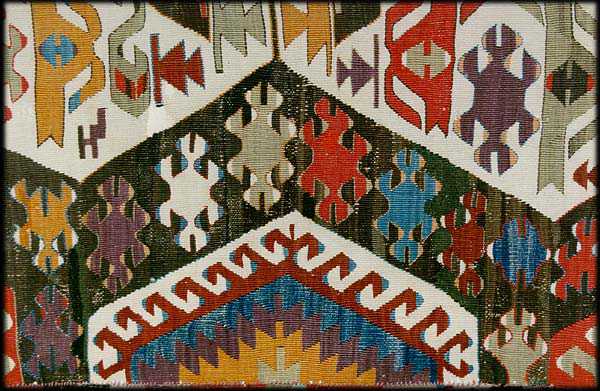
Turkish Kilim Symbols
Most Turkish kilim designs have their roots in the conservative, indigenous, pre-Christian and pre-Islamic backgrounds of the rural population and are related to the basic themes of life: birth, marriage, fertility; spiritual life and happiness; love and unison; and death. They reflect the ancient cults and practices of their ancestors around these events. There are many symbols in the vocabulary of the weaver and many stylizations of each symbol. Unlocking the keys to these symbols reveals a deeper insight into the values, dreams and culture of the Anatolian people and expresses layer upon layer of history and influence in the region.
Nazarlik: an amulet to protect against the evil eye, cause of harm, injury and misfortune.
Elebelinde: symbol of motherhood and fertility, originating in the Neolithic cult of the Mother Goddess.
Ram’s Horn: male fertility, heroism, power and masculinity.
Hands, Fingers and Combs: the hand motif protects against spells and the evil eye while the comb protects birth and marriage.
Tree of Life: symbol of life and paradise; represents man’s yearning for immortality and life after death.
Niche: place of honor, or a door way into paradise.
way into paradise. -
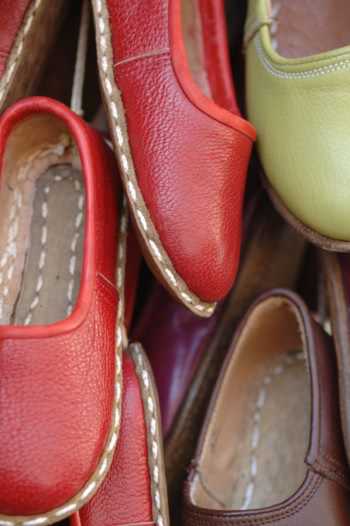
Story Behind the Turkish Idiom “Pabucu Dama Atılmak”
Pabucu Dama Atılmak – Shoe to be thrown to the roof ” to lose favor; to fall from popular esteem; to seem less appealing; to look pale by comparison”…..
The story behind the idiom “Pabucu Dama Atilmak” – to throw someones shoe on the roof is…
At the time of the Ottoman, the organisation the artisans and craftsmen belonged to would regulate trade along with social life. They had come up with an interesting method to try to prevent defective goods, cheap production (with intention of less material, more profit), and bad quality work.
Let’s say you bought a shoe and had it fixed, but it was flawed. The committee would listen to both sides of the story- the plaintiff (customer) and the craftsman. If the plaintiff’s complaint was found to be legitimate, the cost of the shoe would be paid back to him and the shoe itself would be thrown on the roof of the shoemaker as a warning or deterrent to others.
This way, passer-by’s and future customers would know who is a good shoemaker and who isn’t just by looking at their rooftops.
 The shoemakers whose shoes are thrown to the roof would thereby lose out on financial earnings, and lose potential customers thus it would be as if HIS “shoe was thrown on the roof”.
The shoemakers whose shoes are thrown to the roof would thereby lose out on financial earnings, and lose potential customers thus it would be as if HIS “shoe was thrown on the roof”. -

Decorating Pine Tree was a Turkish Ritual
Famous all around world Sumerian specialist Dr. Muazzez İlmiye Çığ said pine tree which used Christmas tree was a Turkish ritual. Pine tree which used Christmas tree spreads to Christian world at century 16. And Turks had been celebrated new year at 22 December when the longest night of year. They had been celebrated new year while decorate pine tree.

Sumerian specialist Dr. Muazzez İlmiye Çığ talk about a tree which named “Akçam’. It is a kind of pine tree. Akçam just used to grew at Turkistan. Turks used to bring Akçam to homes and they used to put some gifts for God under that tree. They used to bind some doeks to boughs. They used to give thanks to God because of God had been given them a good life at pass year. Families used to wear good clothes and visit each one of them and elders. “This ritual reached to Europe. Pine tree isn’t about Noel. Christians accepted as Jesus birth the pine tree at İznik Concile. But Christians didn’t decorate pine tree. This ritual has begun in Germany century 16. It reached to France and spread all around world” said Dr. Çığ.Turks still have been featured to tree. They decorate with some doeks not only pine but some others trees too. They make some vows. Some Turks perceives the making vow means paganism. This tradition attends with local people. More High-educated, high-income and city people see this tradition at some movies, stories or ads. Some of city people buy noel tree and decorate them at Turkey. All these appear that Dr. Çığ’s claims may be right. Turks left all Shamanist totems after adopt Islam. I think decorating pine tree and putting some gift under that were perceived against Islam. And they began to celebrating the New Year according to Islam. They left celebrating December 22. And noel tree turned back Turkish high-level people as Europe and American ritual after centuries.
-
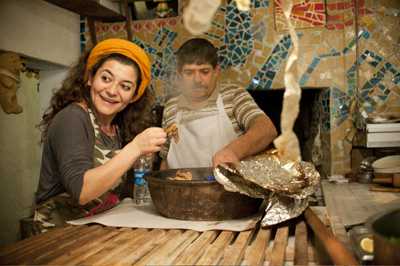
An Istanbul Top Chef’s New Bakery
Datli Maya: Oven of Wonders

About eight years ago, in a cozy little dining room off of an open kitchen, we first encountered the chef Dilara Erbay, who, in her trademark Turko-English patois, barked orders at us and her kitchen staff, thoroughly charmed our table and, most importantly, created delicious, inspired food. Sticking close to traditional Turkish recipes with a subtle tweak or two, our meal that night felt entirely spontaneous, at a time when dining out in Istanbul was mostly predictable. The restaurant had a name but it was really just Dilara’s place to experiment with whatever she picked up from the market that day. She’d promote the night’s creations by SMS messages filled with exclamation points and made-up words. Its location, on the tacky French Street, was not even enough to deter us from becoming regular customers until its final days.
Dilara then surfaced for a short tenure in the kitchen of Cezayir, a grand space just around the corner from her old place on French Street. Her touch was apparent for a while but it quickly faded with her departure. Then at Abracadabra, the behemoth on the Bosphorus – complete with a merchandise line – that was her next venture, we saw bright, encouraging moments – usually when Dilara was in the kitchen for the night – eclipsed by stormy mismanagement. The entrée side of the menu featured a troubled marriage of Turkish and Thai, but the starters were all classic Dilara material. The fragrance of her cinnamon-laced Armenian rice, in essence stuffed mussels without the shell, stays with us to this day. But the restaurant never seemed fully settled. It’s closing, though certainly a low moment, must have been of some relief to Dilara’s fans and perhaps even to the chef herself.
Most recently, we started getting Facebook messages in that familiar Dilara-speak (eg. “…kurufasuliye, hot n sexy”) sent from a place called Datli Maya, the itinerant chef’s latest project, housed in an old Cihangir simit bakery that she recently purchased. Decorated in a rustic utilitarian style, without even the embellishment of a wait staff, the center of attention here is the old oven, as it should be. Modified to burn gas a long time ago, Dilara restored the oven to its previous wood-burning glory, scalped a master baker from Antakya and the concept was born: traditional Turkish food prepared with a chef’s attention to detail and cooked by a true usta in the smoky, natural heat of the oven. That means lahmacun (we prefer the one with onion), pide (don’t miss the one with ground beef and pistachio), a daily guvec (i.e. dishes, from stews to white beans, slow cooked in a clay pot), a spinach and spicy Antakya cheese borek that is in a category all it’s own, and a rotating cast of traditional breads, including the old sesame-studded simit. There are playful drinks on offer like Gazoz and little bottles of ayran, but we prefer to belly up for bottomless cay from the hulking samovar in the corner of the dining room.
Most days, Dilara works with Saban usta, who stands with a slight stoop, bringing him right to the height of the over door. For Dilara, the enterprise almost looks like an apprenticeship, with the veteran chef up to her elbows in ground lamb for tepsi kebab while the usta feeds the oven with a long wooden paddle. Turning away from Abracadabra’s arty fusion cuisine, chauffeured clientele and sweeping views to a business whose only assets are an oven and a delivery scooter might seem like an odd choice for an ambitious chef. But it’s one we applaud and sincerely hope to be indicative of a developing trend, one that sees greater cooperation between the traditional usta and the trained chef.
Within the strict boundaries of what constitutes traditional Turkish food, there is no magic sauce to fall back on. It’s all about technique and the quality of materials, subtleties that Dilara is not skimping on here. Rather than reinventing the baked bean, her kitchen is manipulating every detail to tap vast reserves of flavor that many similar businesses left back in their hometowns when they made their migration to Istanbul. What you get here is delicious village food fresh from the oven, served in Dilara’s way, and once again as spontaneous as when she first fed us eight years ago.
Datli Maya’s Facebook page probably does the best job of summing up what the restaurant is all about. Beside a photo of a dump truck delivering a pile of wood for the oven, it simply says: “If we have wood, we have fire and if we have fire, we can make lovely food!”
Address: Türkgücü Cad. No:59/A, Cihangir (Behind Firuzaga Mosque)
Telephone: +902122929057
Web: www.datlimaya.com
Open everyday 8am-midnight
(photo by Monique Jaques)
via An Istanbul Top Chef’s New Bakery | Istanbul Eats.
